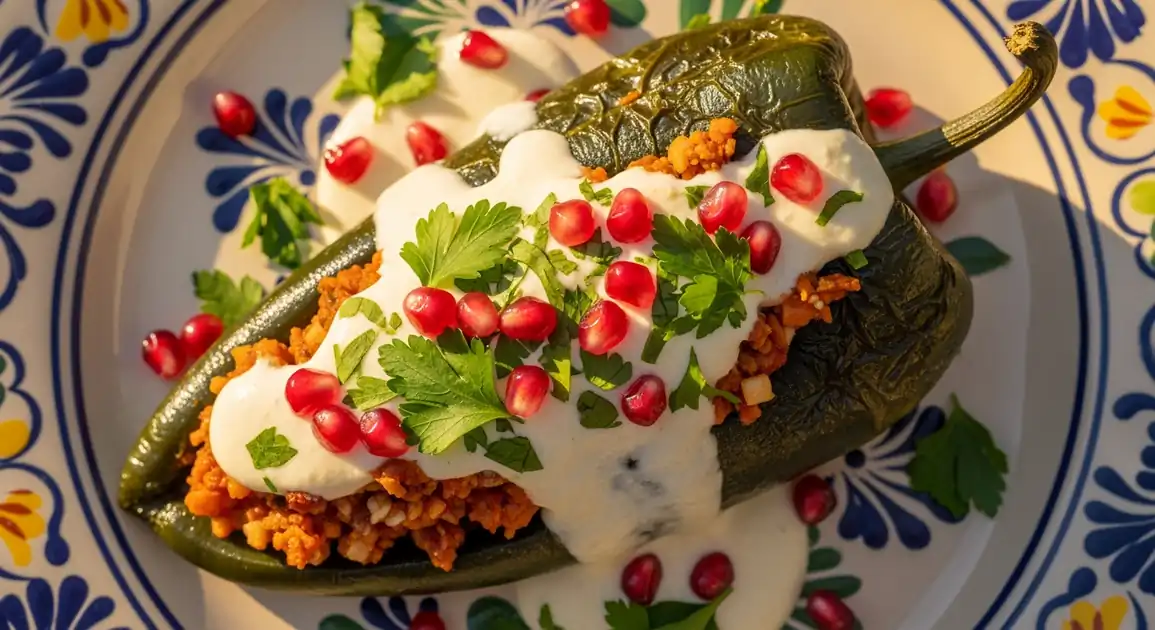Chiles en Nogada
Chiles en Nogada

Description
Chiles en Nogada is one of Mexico's most celebrated patriotic dishes, available countrywide during the independence season but most authentic in central Mexico. The dish symbolizes Mexican culinary identity and nationalism, appearing prominently on restaurant menus from July through September. While found throughout Mexico, the cities of Puebla (its birthplace) and Mexico City offer the most refined versions.
Dietary Information
Serving information
Serving style
Typically served as a single large chile on a decorative plate, sometimes with a side of rice. The chile is covered in white nogada sauce and garnished with pomegranate seeds and parsley. Usually eaten with fork and knife, not as finger food.
Quick facts
Most restaurants serve during standard hours (1 PM - 10 PM), with peak availability during comida (2 PM - 5 PM).
Safety Tips
What to Look For
-
Established restaurants with good reputation for traditional cuisine
Chiles en Nogada requires specialized cooking knowledge and fresh ingredients. Trusted restaurants with experienced chefs are most likely to maintain proper food safety standards for this complex dish.
-
Properly chilled nogada sauce
The walnut cream sauce contains dairy and should be properly refrigerated. It should look fresh, white (not grayish), and have a thick, creamy consistency.
-
Seasonal availability (July-September)
Restaurants serving it only during the traditional season likely use fresh, seasonal ingredients rather than frozen or preserved components.
-
Fresh, vibrant garnishes
Bright red pomegranate seeds and fresh green parsley indicate attention to quality and freshness.
What to avoid
-
Year-round availability at casual establishments
The dish requires seasonal ingredients. Places offering it year-round might use frozen components or shortcuts that affect both quality and potentially safety.
-
Pre-made or day-old appearance
Look for signs like dried-out sauce, soggy chile, or discolored filling. The dish should look freshly assembled.
-
Extremely low prices
Given the labor-intensive preparation and quality ingredients required, unusually cheap Chiles en Nogada might indicate corners being cut.
-
Grayish or yellowish walnut sauce
Discoloration in the sauce indicates oxidation, improper storage, or old walnuts, potentially affecting both taste and safety.
Price information
Price range
Budget tips
- Prices typically range from 250-600 MXN depending on restaurant caliber and location.
- Festival or fair versions might be slightly less expensive (200-300 MXN) but often of lower quality.
- Many restaurants offer special Chiles en Nogada menus or festivals in August/September with fixed prices.
- Expect to pay more at high-end restaurants in tourist areas or luxury hotels (500-800 MXN).
Value indicators
- Hand-peeled walnuts mentioned on menu (labor-intensive traditional method).
- Use of seasonal, local ingredients explicitly noted.
- Generous portion with ample nogada sauce.
- Abundance of fresh pomegranate seeds.
- Proper temperature (room temperature or slightly chilled, not hot or refrigerator-cold).
Where to Find This Dish
Traditional Restaurants
Mid-range to upscale Mexican restaurants specializing in seasonal cuisine.
Established colonial or historic district restaurants, Specialty regional cuisine venues
Lunch (2 PM - 5 PM), Early Dinner (7 PM - 9 PM)
Food Festivals
Seasonal food festivals celebrating Mexican cuisine, particularly in August and September.
Municipal plazas, Cultural centers, Gastronomic festivals
Mid-day to Evening (12 PM - 8 PM)
Markets (Seasonal)
Some upscale food markets feature specialty vendors during the season.
Gourmet markets, Food halls
Lunch (1 PM - 3 PM)
Vendor Tips
- Look for restaurants that prominently advertise their Chiles en Nogada with statements about tradition and fresh ingredients.
- Ask if they peel their walnuts by hand - a sign of traditional quality preparation.
- Some places take reservations specifically for their Chiles en Nogada during peak season (early September).
- Many quality restaurants post their special Chiles en Nogada menu online before the season starts.
How to Order
Regional Variations
-
Traditional Chiles en Nogada
(Chiles en Nogada Tradicionales)
The classic version using pork and/or beef picadillo with a mixture of seasonal fruits (apple, pear, peach), spices, and walnut-cream sauce. Served at room temperature with pomegranate seeds and parsley.
-
Vegetarian Chiles en Nogada
(Chiles en Nogada Vegetarianos)
Replaces meat with mushrooms, textured vegetable protein, or additional fruits and nuts while maintaining the traditional flavor profile.
-
Vegan Chiles en Nogada
(Chiles en Nogada Veganos)
Uses plant-based ingredients for both the filling and the nogada sauce, often substituting cashew or almond cream for the dairy components.
-
Battered Chiles en Nogada
(Chiles en Nogada Capeados)
A less common variation where the stuffed chile is dipped in egg batter and fried before adding the nogada sauce and garnishes.
-
Modern/Fusion Chiles en Nogada
(Chiles en Nogada de Autor)
Contemporary chefs' interpretations that might include non-traditional ingredients or presentation styles while respecting the essential elements of the dish.
Cultural context
History
Chiles en Nogada was reportedly created in 1821 by Augustinian nuns at the Santa Monica convent in Puebla to honor Mexican independence hero Agustín de Iturbide when he visited the city after signing the Treaty of Córdoba. The nuns crafted a dish featuring the colors of the Mexican flag (green, white, and red), using seasonal ingredients available in August-September. The dish has since become a symbol of Mexican culinary heritage and patriotism, traditionally consumed during the independence celebrations in September.
Local significance
Chiles en Nogada represents Mexican patriotism and national identity through its flag colors and historical connections. It celebrates the agricultural bounty of late summer and early fall harvests, particularly in central Mexico. The dish is a source of national pride and appears in cultural representations of Mexican independence.
Eating customs
- Traditionally eaten as a main course, not an appetizer.
- Proper temperature is room temperature or slightly chilled, not hot.
- Each bite should include all components (chile, filling, sauce, pomegranate) for the full experience.
- Often paired with a glass of white wine or rompope (Mexican eggnog liqueur).